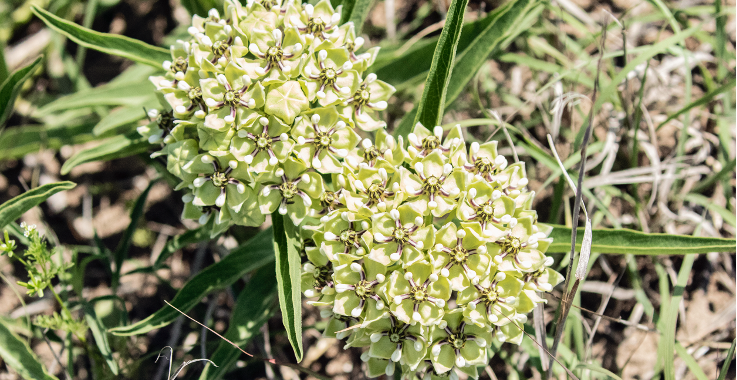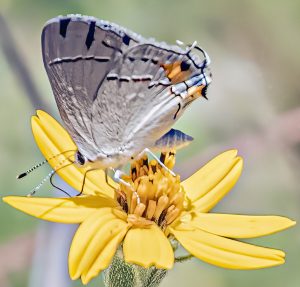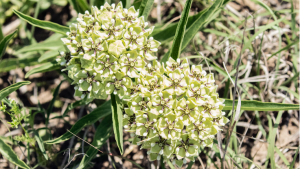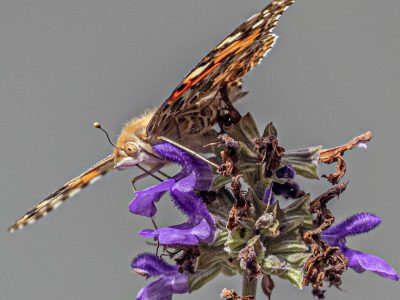Trail Notes: Butterflies, Milkweed, and Other Mysteries
Who doesn’t love butterflies? Okay, maybe that’s not the best question to start with, as I actually had a student once who was afraid of these delicate creatures. The result of an unfortunate childhood encounter? I’m guessing that it was. This exception notwithstanding, though, most people do indeed enjoy having butterflies in their garden, and many wonder how they can attract them more successfully.
The answer isn’t hard: Provide plenty of plants with bright, aromatic (if possible), easy-to-land-on flowers, and maintain a good assortment of host plants—that is, plants that caterpillars like to eat. Offer these two things from February to November, and you’ll have a pretty good chance of enticing butterflies to your landscape.
If you aren’t sure what to plant, a stroll through the Greenbelt is always a good place to begin. Take note of what’s blooming and what butterflies are attracted to it, and then look for those plants at your favorite native plant nursery. It’s not rocket science at all.
So what are some good options? One of the most obvious right now is antelope-horns milkweed, which is currently in bloom. This clump-forming perennial is best known as a food source for both queens and monarchs, the latter of which are critically threatened. Although antelope-horns is the most common species of milkweed in Texas, the monarch will feed on any of the 10 species the National Wildflower Center lists as native to our area. One of these, however, is the subject of some controversy. Tropical milkweed (Asclepias curassavica), the showiest and most readily available of all milkweeds, is thought to be detrimental to monarchs in several ways:
- While all milkweeds contain small levels of cardenolides, the chemical that makes the butterflies unpalatable to predators, that substance in tropical milkweed can, in warmer weather, reach levels that are toxic even to the monarch caterpillars.
- A report by the Xerces Society also points to tropical milkweed’s association with the protozoan parasite Ophryocystis elektroscirrha, or OE for short, that is “linked to lower migration success in the eastern monarch population, as well as reductions in body mass, lifespan, mating success, and flight ability.” Noting that the parasite is carried by the adult monarchs, the report explains, “When native milkweeds die back after blooming, the parasite dies along with them so that each summer’s monarch population feeds on fresh, parasite-free foliage. In contrast, tropical milkweed that remains evergreen through winter allows for OE levels to build up on the plant over time, meaning successive generations of monarch caterpillars feeding on the plant can be exposed to dangerous levels of OE.”
- Its almost continuous bloom cycle and lush foliage, two of the qualities that makes the plant so popular, are also the very things that make it dangerous to monarchs. Quite simply, they encourage the butterflies to hang around longer than they should, disrupting their migration and breeding schedules.
Side note: A good substitute for tropical milkweed (Asclepias curassavica) is the native butterfly weed (Asclepias tuberosa), which has a similar appearance. Unfortunately, this plant is uncommon in the wild in our part of Texas, but it’s available in many nurseries. Butterfly weed is host not just to monarchs, but also to the queen, soldier, and gray hairstreak butterflies.
A final question about milkweed concerns the native pearl or green milkweed vine (Matelea reticulata), which grows in shady areas throughout the greenbelt. Is this often-inconspicuous plant a host for monarchs, too? Most sources say yes, though its role seems less obvious than that of its more robust cousins. In any case, it’s a desirable plant not only for its benefit to wildlife, but also for its “ green star-shaped flowers with a pearly iridescent center” that the National Wildflower Center describes as “lovely and curious.”
Other Greenbelt natives that serve as host plants to butterflies include the following. This partial list comes from Preservation Texas and has been edited to include only plants likely to be found in the Greenbelt. Many of these are also nectar sources but may not currently be in bloom.
Giant Swallowtail—Hop Tree (Ptelea trifoliata), Toothache Tree (Zanthoxylum hirsutum)
Eastern Black Swallowtail—Prairie Parsley (Polytaenia nuttallii)
Spicebush Swallowtail—Spicebush (Lindera benzoin)
Two-Tailed Tiger Swallowtail—Hop Tree (Ptelea trifoliata)
Gulf Fritillary, Zebra Longwing and Julia—Bush Croton (Croton fruticulosus)
Question Mark—Hackberry Trees (Celtis sp.) Elm Trees (Ulmus sp.)
Dogface Sulphur—Kidneywood (Eysenhardtia texana)
Sleepy Orange Sulphur—Lindheimer’s Senna (Cassia lindheimerii)
Dainty Sulphur—Greenthread (Thelesperma filifolium), Navajo Tea (Thelesperma simplicifolium)
Cloudless Sulphur—Lindheimer’s Senna (Cassia lindheimeri), Partridge Pea (Chamaecrista fasciculata)
Monarch—Milkweeds (Asclepias spp.), Milkweed Vine (Matelea spp.) less frequently
Queen—Green Milkweed (Asclepias viridis), Texas Milkweed (Asclepias texana)
Red Admiral—Stinging Nettles (Urtica spp.)
Painted Lady—Texas Thistle (Cirsium texana), Plants in the Mallow family
Buckeye—Wild Petunia (Ruellia spp.)
Bordered Patch—Cowpen Daisy (Verbesina encelioides), Golden-Eye (Viguiera dentata), Zexmenia (Zexmenia hispida), Many other composites used
Crescentspot—Frogfruit (Phyla spp.)
Common Snout—Hackberry Tree (Celtis spp.)
Checkered Skipper—Plants in the Mallow family
Clouded Skipper—Big Bluestem (Andropogon gerardii), Little Bluestem (Schizachyrium scoparium), Many other grass skippers using most any native grass available
Common Wood Nymph—Big Bluestem (Andropogon gerardii), Purpletop Tridens (Tridens flavus)
Red Satyr—An assortment of native grasses
Gray Hairstreak—Many different host plants
Great Blue Hairstreak—Mistletoe (Phoradendro tomentosum)
Written by Susan Hanson, member of the SMGA board, chair of the outreach committee, and editor of the Loop





